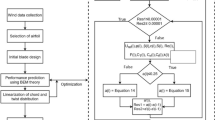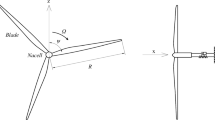Abstract
The modelling of blade geometry is the first step to be taken before the boundary element momentum theory (BEMT) analysis can be conducted on the wind turbine (WT). Yet it is a crucial step in establishing the best aerodynamic achievement the WT can give. In this paper, the power coefficient of a WT utilizing different blade geometries are determined and compared using the BEMT method. The blade geometries are obtained from the proposed formulas in literature and from the recommended polynomials that are based on experimental works. All blades are analyzed using the extended BEMT that includes the tip loss effect, the axial induction correction factor, \(a\) and the stall effect. At the same time, the obtained tapered blade usually varies in its chord length and twist angle in a nonlinear manner with respect to radius of the blade. As this may cause manufacturing difficulty of the blade and increasing the wind turbine manufacturing cost, the best nonlinear distribution based on the BEMT analysis conducted has been linearized through a process of linearization. A comparison is made on the aerodynamic performances of the WT for the linearized and nonlinear blades. The study shows that the geometry of the blade is better with the use of the empirical formula that gives high power at higher tip speed ratio (TSR) while having lower axial thrust. Furthermore, comparing the linear and nonlinear blade, it can be concluded that linearizing the chord length and twist angle is a good practice because with its simpler construction, the maximum power of 200 W that was produced is at par with the nonlinear one, while the axial thrust is much lower at 125N when compared with 225N in the case of nonlinear blade.
Access this chapter
Tax calculation will be finalised at checkout
Purchases are for personal use only
Similar content being viewed by others
References
Ren H et al (2020) Development of a green and sustainable manufacturing process for gefapixant citrate (MK-7264) part 1: introduction and process overview. Organ Process Res Develop 24(11):2445–2452
Bhatt Y, Ghuman K, Dhir A (2020) Sustainable manufacturing: bibliometrics and content analysis. J Clean Prod 260:120988
Rasid ZA et al (2011) Thermal buckling and post-buckling improvements of laminated composite plates using finite element method. Key Eng Mater 471–472:536–541
Wahab A et al (2018) Dynamic instability of high-speed rotating shaft with torsional effect. Int J Autom Mech Eng 15(4):6034–6051
Rasid ZA, Zahari R, Ayob A (2014) The instability improvement of the symmetric angle-ply and cross-ply composite plates with shape memory alloy using finite element method. Adv Mech Eng 6:632825
Roslan S et al (2019) Dynamic instability response of smart composite material. Mater Wissenschaft und Werkstofftechnik 50(3):302–310
Razak MA et al (2019) Energy consumption clustering analysis in residential building. Symposium on intelligent manufacturing and mechatronics. Springer, Melaka, pp 436–450
Roslan SAH, Rasid ZA, Ariffin AK (2023) Extended blade element momentum theory for the design of small-scale wind turbines. J Adv Res Appl Mech 101(1):62–75
Mehta PR, Kale RV (2022) Parameters affecting design of wind turbine blade: a review. In: Chaurasiya PK, Singh A, Verma TN, Rajak U (eds) Technology innovation in mechanical engineering. Lecture notes in mechanical engineering. Springer, Singapore
More A, Roy A (2020) Design and weight minimization of small wind turbine blade for operation in low-wind areas. In: Singh S, Ramadesigan V (eds) Advances in energy research. Springer proceedings in energy 2. Springer, Singapore
Manwell JF, McGowan JG, Rogers AL (2010) Wind energy explained: theory, design and application. Wiley
Ingram G (2011) Wind turbine blade analysis using the blade element momentum method, version 1.1. Durham University, Durham
Jamieson P (2018) Innovation in wind turbine design. Wiley
Bakırcı M, Yılmaz S (2018) Theoretical and computational investigations of the optimal tip-speed ratio of horizontal-axis wind turbines. Eng Sci Technol Int J 21(6):1128–1142
Burton T et al (2011) Wind energy handbook. Wiley
Batu T, Lemu HG (2020) Comparative study of the effect of chord length computation methods in design of wind turbine blade. In: Wang Y, Martinsen K, Yu T, Wang K (eds) Advanced manufacturing and automation IX. IWAMA 2019. Lecture notes in electrical engineering, vol 634. Springer, Singapore
Jha D, Singh M, Thakur AN (2021) A novel computational approach for design and performance investigation of small wind turbine blade with extended BEM theory. Int J Energy Environ Eng 12:563–575
Lee MH, Shiah YC, Bai CJ (2016) Experiments and numerical simulations of the rotor-blade performance for a small-scale horizontal axis wind turbine. J Wind Eng Ind Aerodyn 149:17–29
Hsiao FB, Bai CJ, Chong WT (2013) The performance test of three different horizontal axis wind turbine (HAWT) blade shapes using experimental and numerical methods. Energies 6(6):2784–2803
Madi M et al (2021) Comparative analysis of taper and taperless blade design for ocean wind turbines in Ciheras coastline, West Java. Kapal Jurnal Ilmu Pengetahuan dan Teknologi Kelautan 18(1):8–17
Anderson M, Milborrow D, Ross J (1982) Performance and wake measurements on a 3 m diameter horizontal axis wind turbine. Comparison of theory, wind tunnel and field test data. In: International symposium on wind energy system, processing (United Kingdom)
Liu X, Wang L, Tang X (2013) Optimized linearization of chord and twist angle profiles for fixed-pitch fixed-speed wind turbine blades. Renew Energy 57:111–119
Tahani M et al (2017) Aerodynamic design of horizontal axis wind turbine with innovative local linearization of chord and twist distributions. Energy 131:78–91
Sedaghat A, Mirhosseini M, Moghimi Zand M (2014) Aerodynamic design and economical evaluation of site specific horizontal axis wind turbine (HAWT). Energy Equip Syst 2(1):43–56
Rahgozar S et al (2020) Performance analysis of a small horizontal axis wind turbine under the use of linear/nonlinear distributions for the chord and twist angle. Energy Sustain Develop 58:42–49
Abdelsalam AM et al (2021) Experimental study on small scale horizontal axis wind turbine of analytically-optimized blade with linearized chord twist angle profile. Energy 216:119304
Sena B et al (2021) Determinant factors of electricity consumption for a Malaysian household based on a field survey. Sustainability 13(2):818
Acknowledgements
This work is funded by the UTMER Scheme grant “Q.K.130000.2656.18J24”, provided by the Malaysia-Japan International Institute of Technology, a faculty of the Universiti Teknologi Malaysia, Skudai, Malaysia. The authors acknowledge this support.
Author information
Authors and Affiliations
Corresponding author
Editor information
Editors and Affiliations
Rights and permissions
Copyright information
© 2024 The Author(s), under exclusive license to Springer Nature Singapore Pte Ltd.
About this paper
Cite this paper
Roslan, S.A.H., Umar, N., Rasid, Z.A., Arifin, A.K. (2024). The Geometric Modelling and Linearization of Small-Scale Wind Turbine Blades for Optimized Renewable Energy. In: Malik, H., Mishra, S., Sood, Y.R., Iqbal, A., Ustun, T.S. (eds) Renewable Power for Sustainable Growth. ICRP 2023. Lecture Notes in Electrical Engineering, vol 1086. Springer, Singapore. https://doi.org/10.1007/978-981-99-6749-0_13
Download citation
DOI: https://doi.org/10.1007/978-981-99-6749-0_13
Published:
Publisher Name: Springer, Singapore
Print ISBN: 978-981-99-6748-3
Online ISBN: 978-981-99-6749-0
eBook Packages: EnergyEnergy (R0)




